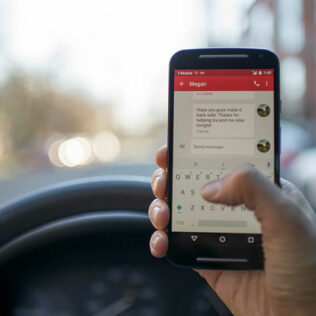It’s no secret that distracted driving can pose a significant threat to everyone on the road, but do you know exactly how dangerous it really is? Distracted driving is responsible for 1 in every 5 crashes involving an injury, and 6 of every 10 teen car crashes.
Most people associate the term “distracted driving” with texting and driving. Driving while using a smart phone is certainly one form of distraction, but there are many other types that can be extremely dangerous. First, let’s define “distraction” as it applies to driving. Most trustworthy establishments, including the CDC, the National Highway and Traffic Safety Administration, and AAA define distracted driving as anything that diverts the driver’s mind, eyes, or hands from the task at hand.
Some of the most common forms of distracted driving are:
- Talking on the phone, hand-held or hands-free
- Texting or emailing
- Checking social media or using a smartphone app
- Taking pictures or video
- Surfing the web
- Changing a music station or playlist
- Using navigation
- Eating
- Putting on makeup, or another form of grooming
After talking on a hand-held cell phone while driving proved dangerous, many car manufacturers and tech companies created blue tooth devices for hands-free calls. However, this distraction has since proved no better than using a hand-held phone. According to the National Safety Council, nearly a quarter of all car crashes involve cell phone conversations, whether hand-held or hands-free.
Teenage drivers are picking up bad habits of distracted driving from the get go, whether from the bad example of adults or simply because they are new, inexperienced drivers. A leading research study for teenage car crashes, The Youth Risk Behavior Surveillance System, found, on average, 2 out of every 5 high school students who drive in the past 30 days has sent a text message or email while driving. However, smart phone use isn’t the only danger. In some studies, teenage drivers have proven themselves to be more distracted by the passengers in their cars.
According to a study by AAA, the most common forms of distraction in teenage drivers includes:
- Talking with passengers
- Using a cellphone
- Looking at something in the car
- Looking at something outside of the car
- Singing or dancing to music
- Doing hair or makeup, etc.
- Reaching for something
Distracted driving caused 3,477 deaths in 2015 alone, and experts estimate 2016 claimed even more lives. In addition to the many safety hazards of distracted driving, it can also lead to serious legal consequences. If you kill another person while driving distractedly, you may be charged with vehicular manslaughter and could face years in prison. People usually associate drunk driving with serious legal repercussions, but distracted driving can be just as detrimental to your future.
In order to stay out of harm’s way and avoid distraction, safety experts suggest drivers remove temptation by putting phones in glove boxes or tucked away in purses while driving. Moreover, drivers should choose a music station or playlist before driving, avoid eating or grooming in the car, and get navigation systems programmed before starting to drive..
Even if you do everything you can to remain attentive while driving, you cannot control the conduct of a distracted driver. If you are in an accident with a distracted driver, and you’ve suffered an injury, our firm can help.
Contact Langer & Langer for help with your car accident case.

